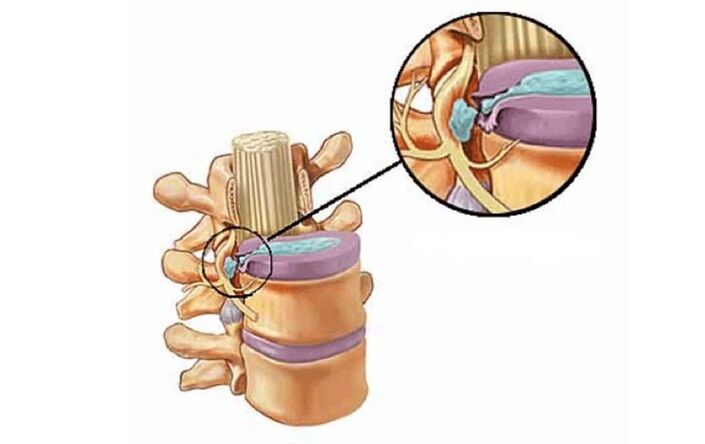Osteochondrosis rarely develops in the thoracic spine - the intervertebral discs in it are smaller and thinner than in the cervical or lumbar spine. The thoracic region is less mobile, with the main load falling on the ribs and sternum.
In contrast to cervical and lumbar osteochondrosis, chest symptoms differ only at the site of pain. The nature and duration of the pain are similar. Prolapse of the thoracic region does not affect the spinal cord. Read about this and more.
Stages of pathology
Over time, osteochondrosis usually progresses. Depending on the severity of the manifestation, the pathology is divided into 4 stages.
Preclinics
There are minimal abnormalities in the spine. Mild pain syndrome may occur, and the back muscles become tense. Chest pain - chest pain - is possible, but it is rare.
Discogenic sciatica
There is a change in the structure of intervertebral discs. Moderate pain may occur in the affected part of the spine. The patient is effective. But its muscle endurance indicators are declining.
Vascular-radicular
At this stage, the annulus fibrosus is completely destroyed. Disc herniation is formed, the deformation process of the fibrous ring continues, leading to its rupture. The nucleus pulposus then falls out into the space under the ligaments. Disc herniation is formed. The process affects the tissues at the disc, and the work of the blood vessels, muscles, nerves and ligaments is disrupted. The disease becomes chronic.
Changes in the shape of the bone structure
The vertebrae become rough, the surface becomes ribbed and uneven. Muscles begin to contract spontaneously, leading to limited movement of the entire spine or a certain vertebra. Nerve protrusion protrudes from the spinal cord. This leads to a deterioration of the impulses coming from the brain to the tissues and organs of the body.
The mobility of the spine as a whole is maintained, but the individual vertebrae become fragile and can collapse easily. If the disease is not treated, it goes into the fourth stage.
Regeneration of intervertebral disc tissue and replacement of scar tissue
The damaged intervertebral disc is unable to perform its functions well, leading to convergence of the body of adjacent vertebrae. This leads to abnormalities in the intervertebral joints called spondyloarthrosis. In this case, the vertebrae may twist or move relative to adjacent vertebrae.
The organization activates its own compensation mechanisms. To relieve the load on the damaged disc, the vertebrae flatten and widen. This increases the area. The collapsed tissue of the annulus fibrosus can be replaced by bone.
Sometimes this reduces the pain, but as the vertebrae grow, the holes in the spine are still narrowed - the nerve is pinched.
Symptoms of the disease
Symptoms of breast osteochondrosis are often caused by:
- the age of the patient;
- spinal sensation;
- the stage of development of the disease;
- the condition of the patient is a remission or exacerbation of the disease.
Symptoms include:
- radiculopathy - painful damage to the nerve endings in the spinal cord;
- abdominal syndrome;
- heart syndrome, changes in the heart muscle - characterized by severe pain and unresponsiveness to nitroglycerin;
- lung syndrome: congestion, hypoxia in the lungs;
- paresthesia - a feeling of "goosebumps" on the body;
- pain in the area of the compressed nerve;
- decreased sensitivity to temperature fluctuations and touch;
- violation of the motor functions of the spine.
The patient's body temperature does not rise. This serves as a sign that allows the pathology to be distinguished.
The extent of the disease
Lumbago
It is a sharp pain that penetrates the body. It manifests itself when lifting heavy objects and doing other physical activities - the pain is similar to an electric shock.
From a morphological point of view, an unexpected rupture of the intervertebral disc occurs when the load is too high. This traumatic injury leads to nerve irritation - pain occurs.
The muscles are tense and that is well expressed. Lumbar lordosis is smoothed out. Thus, the load is redistributed and the intervertebral disc is further compressed, leading to edema, which increases pain.
When the pathology is concentrated in the neck region, cervicalgia appears - this manifests itself in pain when the head is rotated and the neck muscles are touched. In case of exacerbation, cervicocranalgia is often observed, which is manifested in the fact that a person has a severe headache in the occiput region. Tinnitus, dizziness, flies in the eyes and sore teeth may occur.
Dizziness
They appear as a result of narrowing of the cavity of the spinal canal. The intervertebral disc protrudes and compresses the vessels. The brain is unable to get the amount of blood it needs. You may experience sharp headaches, numb hands, and sore shoulders.
Difficulty breathing, which causes not enough oxygen to enter the brain. This causes stabbing pain in the heart region.
Intervertebral hernia
At this stage of development, the image appears to be quite severe - the spinal canal and intervertebral cavities have narrowed significantly. This can result in injury - a dangerous fault. Surgical intervention is often required at this stage of the disease.
Treatment of third-degree osteochondrosis depends on root compression. It is possible to use the same techniques as at the secondary level. However, if the pain persists for fifteen days and symptoms of prolapse (vertebral prolapse) occur, surgery is needed.

Growth in the vertebrae
Usually, at this stage of the disease, the manifestations of the hernia disappear, the symptoms of the disease are less pronounced, but it is noticeable that the spine is unstable and the vertebrae may slip or twist relative to each other.
Growth of vertebral bodies can occur during this time - this is called osteophytes. The growths lead to compression of the spinal nerves, overlapping the spinal canal, which is called secondary narrowing of the spinal canal. As a result, compression of the spinal cord is possible, leading to ischemia.
This degree of the disease also includes the consequences of previous operations to remove the hernia. They can manifest as disturbed innervation, paresis, inflammation.
Dorsago and dorsalgia
Symptoms of chest osteochondrosis depend directly on the area of the spinal lesion. The vertebral syndromes of dorsago and dorsalgia are most commonly distinguished.
Dorsago suddenly occurs in the form of sharp pain that occurs in the chest area. This often happens when a person is in a sitting position for a long time without changing their posture. Pain can occur if a person's body position is physiologically uncomfortable. It is also possible if you do monotonous work for a long time.
Dorsago is also called the "chest lumbago. "When this happens, the muscles in your back and chest become so tense that it will be difficult to breathe.
Sometimes the pain travels along the ribs to the sternum and radiates to the shoulder blade area. Sometimes the patient may feel that it is a heart attack. However, no abnormalities are observed during the electrocardiogram. If you are taking nitroglycerin or other heart medicines, there will be no results.

Avoid staying in one position for long periods of time. Sedentary work is a major cause of osteochondrosis.
Dorsalgia is a mild pain for a long time, sometimes even during these weeks. The inflamed part of the spine gives "dull" pain. This is uncomfortable, so one usually sees a doctor.
Dorsalgia can be expressed by:
- the pain is exacerbated if the person inhales deeply or coughs;
- muscles overstretched;
- motor activity in the cervical or lumbar region decreases;
- muscle cramps;
- the pain is worse at night and when the person is doing physical activity.
Dorsalgia is superior and inferior. First, the main painful manifestations are concentrated in the upper chest, in the neck. In the second case, it mainly hurts the sacrum and lower back.
The symptoms of dorsalgia are very similar to the first manifestations of pneumonia. This is important to note in order to diagnose the disease in a timely manner. If the diagnosis is incorrect and treatment is prescribed, the patient's condition will only get worse.
When a woman is breastfeeding a baby, she may experience such manifestations of osteochondrosis. In this situation, you only need to see a doctor to treat the disease, taking into account all the nuances.
It is important to consider all the risks of using certain medications so as not to harm your baby and your own health.
Atypical symptoms
In some cases, the symptoms of osteochondrosis of the thoracic spine are completely atypical. Someone may not even know about the disease, as the symptoms are often similar to those of other pathologies. They need to be examined in more detail and the situation as a whole analyzed:
- it is possible for pain to mimic the heart that develops during angina pectoris and heart attack; coronary vasodilators such as nitroglycerin have no effect; and the ECG shows no abnormality;
- pains similar to those in women with breast disease may occur; this pain can last for a long time; no mammary gland problems are detected during the examination;
- the hip and abdomen may be painful, the symptoms are not like gastritis and colitis; pain under the right rib, similar to hepatitis or cholecystitis; digestion is usually disturbed - this is also a characteristic symptom of osteochondrosis, which occurs due to disturbances in the innervation of internal organs; it is necessary to find out what caused the disruption of the digestive process of food, indeed the cause of osteochondrosis of the chest;
- the process of urination and sexual function may be disrupted as the innervation of the urinary system is distorted;
- when thoracic osteochondrosis worsens, long-term, weekly pain may occur in the sternum, very similar to pain in mammary gland diseases; a visit to the mammologist will allow the cause of the pain to be identified.
These symptoms are associated with manifestations of back pain as well as intercostal neuralgia. The onset of atypical symptoms is usually observed in the evening. It is usually not whiter in the morning. The pain increases during the day if the right conditions are created for it, causing pain.






















